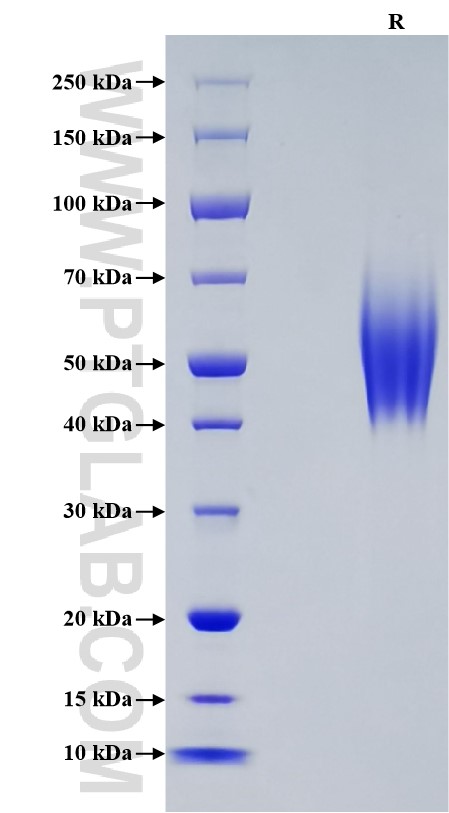Recombinant Human CEACAM-6/CD66c protein (Myc Tag, His Tag)
种属
Human
纯度
>95 %, SDS-PAGE
标签
Myc Tag, His Tag
生物活性
EC50: 12-46 ng/mL
验证数据展示
产品信息
| 纯度 | >95 %, SDS-PAGE |
| 内毒素 | <0.1 EU/μg protein, LAL method |
| 生物活性 | Immobilized Human CEACAM-6 (Myc tag, His tag) at 2 μg/mL (100 μL/well) can bind Human CEACAM-8 (hFc tag) with a linear range of 12-46 ng/mL. |
| 来源 | HEK293-derived Human CEACAM-6 protein Lys35 -Gly320 (Accession# P40199) with a Myc tag and a His tag at the C-terminus. |
| 基因ID | 4680 |
| 蛋白编号 | P40199 |
| 预测分子量 | 36.3 kDa |
| SDS-PAGE | 40-70 kDa, reducing (R) conditions |
| 组分 | Lyophilized from 0.22 μm filtered solution in PBS, pH 7.4. Normally 5% trehalose and 5% mannitol are added as protectants before lyophilization. |
| 复溶 | Briefly centrifuge the tube before opening. Reconstitute at 0.1-0.5 mg/mL in sterile water. |
| 储存条件 |
It is recommended that the protein be aliquoted for optimal storage. Avoid repeated freeze-thaw cycles.
|
| 运输条件 | The product is shipped at ambient temperature. Upon receipt, store it immediately at the recommended temperature. |
背景信息
Carcinoembryonic antigen-related cell adhesion molecule 6 (CEACAM6), belonging to the immunoglobulin superfamily, is cell-adhesion protein on neutrophils. CEACAM6 is expressed in neutrophils and numerous tumor cell lines. CEACAM6 mediates homophilic and heterophilic cell adhesion with other carcinoembryonic antigen-related cell adhesion molecules, such as CEACAM5 and CEACAM8. It plays a role in neutrophil adhesion to cytokine-activated endothelial cells and plays a role as an oncogene by promoting tumor progression; positively regulates cell migration, cell adhesion to endothelial cells and cell invasion. CEACAM6 is also involved in the metastatic cascade process by inducing gain resistance to anoikis of pancreatic adenocarcinoma and colorectal carcinoma cells.
参考文献:
1.Kuroki M, et al. (2001). Journal of leukocyte biology. 70(4): 543-50 2.Kuijpers TW, et al. (1992). J Cell Biol. 118(2):457-66 3.Blumenthal RD, et al. (2005). Cancer research. 65(19):8809–8817 4.Ordoñez C, et al. (2000). Cancer Res. 60(13):3419-24 5.Duxbury MS, et al. (2004). Oncogene. 23(2):465-73

